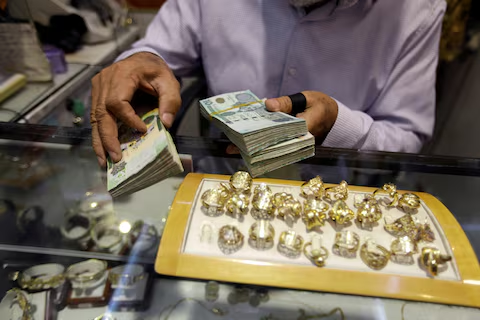Unofficial Libyan banknotes have been exchanged for real dollars and contributed to the dinar’s devaluing, three sources familiar with the matter told Reuters, adding that some notes were printed by Russia and exported to eastern Libya this year while others were printed illicitly within Libya.
The new banknotes have been described as counterfeit by the Central Bank of Libya (CBL) in Tripoli but are being changed into hard currency on the black market or through local banks, according to a source in Libya’s eastern government, a Libyan banking source, and a diplomatic source.
The money has been used to fund infrastructure projects in the east following last year’s devastating floods, the eastern government source and the banking source said. The money may also be used to finance Russian mercenary activity in Libya and the Sahel, the diplomatic source said.
Russia’s role in the infusion of new banknotes into Libya was flagged to Reuters by The Sentry, an international investigative and policy group focused on corruption and war crimes.
Neither the Tripoli-based Central Bank of Libya nor its branch in Benghazi responded to requests for comment from Reuters. There was no immediate response from the Libyan National Army, which holds all of eastern Libya, to a Reuters request for comment.
Russia’s state money printer, Goznak, did not respond to a written request for comment.
Libya split in 2014 between warring eastern and western factions. Despite a 2020 truce and efforts to formally reunify institutions, a political solution has proven elusive with new bursts of conflict constantly on the horizon.
The U.S. State Department in June sanctioned Goznak for printing more than $1 billion in counterfeit Libyan currency, without saying where or when the notes were printed or delivered.
Russia had supplied eastern authorities with several billion dinars from 2016 until a 2020 ceasefire, helping allied eastern commander Khalifa Haftar and the government he backed in Benghazi. Its provision of new banknotes this year was not previously known.
The dinars imported between 2016-20 were formally issued by CBL’s eastern branch in Benghazi and bore the signature of its governor Ali al-Hibri. Their issuance aggravated economic splits inside Libya, with different exchange rates in different parts of the country.
After the ceasefire and banking reunification efforts, the main CBL branch in Tripoli under governor Sadiq al-Kabir accepted the Russian-printed notes issued by Hibri as legal tender.
‘SERIOUS THREAT’ TO BANKING SYSTEM
Hibri was replaced in 2022. Kabir then said the new notes should not be used, but authorities in eastern Libya have insisted that any institutions declining them would be punished.
Eastern Libya, where the national parliament is based, is in effect under the control of Haftar, who deployed Russian mercenaries from the Wagner group during fighting in 2019-20, according to U.N. experts. The Russian fighters have remained, the United States military has said.
“The Haftar family’s hegemonic control over eastern Libya poses a serious threat to the country’s entire banking system,” said Charles Cater, head of investigations at The Sentry.
Most of the unofficial currency is in 50-dinar notes. The CBL issued a statement earlier this year identifying four kinds of 50-dinar note: those officially printed for the central bank, those printed in the past by Goznak for the eastern CBL branch under Hibri, and two new issuances that it called counterfeit.
The diplomatic source said one of those issuances was of higher quality and was printed in Russia and imported. The other less sophisticated notes appear to have been printed inside Libya, the source said.
The Libyan banking source and the eastern government source both said an illicit dinar-printing operation was taking place in eastern Libya.
Dinars are converted to hard currency either through black market money changers or via deposits made in eastern banks by shell companies that use import letters of credit to send U.S. dollars from the central bank to companies overseas, the three sources familiar with the matter told Reuters.
“The ‘exporter’ is in fact a shell company controlled by the same individuals behind the banknote-printing operation. No goods are shipped and the dollars are pocketed by the criminal network,” said Cater.
The CBL briefly stopped issuing letters of credit in the past, amid allegations that some importers were using them to obtain cheap dollars.
To counter the impact of counterfeit notes, the CBL announced in April that it would withdraw all 50-dinar notes from circulation by the end of August.
Libya’s dinar began falling last year but slid more quickly during early 2024, a slump the diplomatic source and the banking source attributed to the infusion of new notes in the east.
The diplomatic source said it was “a major concern” that the Russians were printing dinars that were being converted on the black market into hard currency, impacting the dinar and ultimately being used to pay for Wagner-related debts or for the Africa Corps – the name of the Russian military presence in Africa that has succeeded Wagner group since the death of Wagner founder Yevgeny Prigozhin in 2023.
